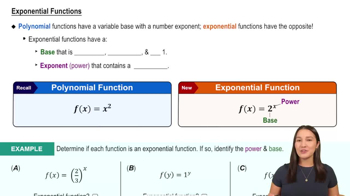Table of contents
- 0. Functions7h 52m
- Introduction to Functions16m
- Piecewise Functions10m
- Properties of Functions9m
- Common Functions1h 8m
- Transformations5m
- Combining Functions27m
- Exponent rules32m
- Exponential Functions28m
- Logarithmic Functions24m
- Properties of Logarithms34m
- Exponential & Logarithmic Equations35m
- Introduction to Trigonometric Functions38m
- Graphs of Trigonometric Functions44m
- Trigonometric Identities47m
- Inverse Trigonometric Functions48m
- 1. Limits and Continuity2h 2m
- 2. Intro to Derivatives1h 33m
- 3. Techniques of Differentiation3h 18m
- 4. Applications of Derivatives2h 38m
- 5. Graphical Applications of Derivatives6h 2m
- 6. Derivatives of Inverse, Exponential, & Logarithmic Functions2h 37m
- 7. Antiderivatives & Indefinite Integrals1h 26m
- 8. Definite Integrals4h 44m
- 9. Graphical Applications of Integrals2h 27m
- 10. Physics Applications of Integrals 2h 22m
0. Functions
Properties of Functions
Problem 1.21
Textbook Question
State whether the functions represented by graphs A , B , C and in the figure are even, odd, or neither. <IMAGE>
 Verified step by step guidance
Verified step by step guidance1
Step 1: Understand the definitions of even and odd functions. An even function satisfies f(x) = f(-x) for all x in its domain, meaning it is symmetric with respect to the y-axis. An odd function satisfies f(-x) = -f(x) for all x in its domain, meaning it is symmetric with respect to the origin.
Step 2: Analyze the symmetry of each graph. For graph A, check if the graph is symmetric with respect to the y-axis (even) or the origin (odd).
Step 3: Repeat the symmetry analysis for graph B. Determine if graph B is symmetric with respect to the y-axis or the origin.
Step 4: Perform the same symmetry check for graph C. Look for y-axis symmetry or origin symmetry to classify the function.
Step 5: Based on the symmetry analysis, classify each function as even, odd, or neither. If a graph does not exhibit symmetry with respect to the y-axis or the origin, it is neither even nor odd.
 Verified video answer for a similar problem:
Verified video answer for a similar problem:This video solution was recommended by our tutors as helpful for the problem above
Video duration:
3mPlay a video:
Was this helpful?
Key Concepts
Here are the essential concepts you must grasp in order to answer the question correctly.
Even Functions
A function is considered even if its graph is symmetric with respect to the y-axis. Mathematically, this means that for every x in the domain, f(-x) = f(x). Common examples include f(x) = x² and f(x) = cos(x). Identifying even functions involves checking this symmetry visually or through algebraic verification.
Recommended video:

Exponential Functions
Odd Functions
A function is classified as odd if its graph is symmetric with respect to the origin. This means that for every x in the domain, f(-x) = -f(x). Examples include f(x) = x³ and f(x) = sin(x). To determine if a function is odd, one can look for this rotational symmetry or apply the algebraic condition.
Recommended video:

Properties of Functions
Neither Even Nor Odd Functions
A function is neither even nor odd if it does not exhibit the symmetry properties of either category. This can occur when the function has terms that do not conform to the even or odd definitions, such as f(x) = x² + x. To classify a function as neither, one must show that it fails both symmetry tests.
Recommended video:

Properties of Functions

 6:21m
6:21mWatch next
Master Properties of Functions with a bite sized video explanation from Nick
Start learningRelated Videos
Related Practice

